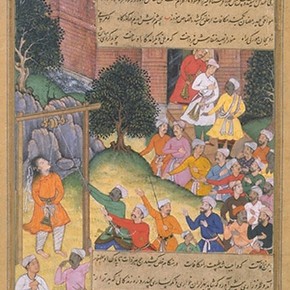Conservation Journal
July 1998 Issue 28
Life as an Intern

Figure 1. 'Akharnama Folio, Execution of Shah Abul Ma'ali at Kabul', dated 1586-9, Museum no. IS 2-1896-34/117. (click image for larger version)
In January, I started a three-month internship in the Paper Conservation Section at the Victoria and Albert Museum, thanks to a generous grant from the Nehru Trust Fellowship. I have previously completed two internships: one at the Indian Council of Conservation Institutes (ICCI) at Lucknow in India, and one at Camberwell College of Arts in London.
I work at the Art Conservation Centre, Indian National Trust for Art and Cultural Heritage, New Delhi, India, as a paintings conservator. The studio was set up for conservation of 19th and 20th century oil paintings, but clients also bring us works on paper, textiles, ceramics, wooden material, metals and glass. I entered the profession as an on-the-job trainee in 1990. As a fresh recruit straight from art school, for the first three months I was only allowed to observe conservation procedures. I did the menial jobs - cleaning the studio before the conservator arrived and washing up when he had finished. It certainly taught me a lot about looking after my equipment and the advantages of being organised before starting to work!
My conservation education began in the traditional Indian manner. Knowledge was imparted through dialogue and from each object treatment. After two years I recognised that I needed to attend an organised course, and decided to do a certificate course in paper conservation. Here practical work was replaced by lectures and written work. (A Masters degree course in conservation is now available in India.)
I had wanted to work on Indian miniatures and at the V&A I was given two folios from the Akbarnama. As a conservator it is far beyond my wildest dreams to be handling objects as important as these. The approach towards the problems of losses, flaking and previous repairs has been one of minimum intervention.The areas of flaking were consolidated locally and the previous repairs removed. The object was slowly humidified to relax and flatten it, ready for mounting. The Indian approach would have included extensive in-painting.
I also participated in the treatment of some of the posters for the major exhibition 'The Power of the Poster'. This was something new for me in several ways. First, the size of some of the objects was larger than anything I had ever worked on before. Second, it taught me how to work alone. I had to overcome my fear of handling large objects by myself. I also learned to use tools which were new to me (japanese brushes and paper), and new treatment techniques.
The experience of working in the Paper Conservation Studio has been a very rewarding one. It has given me the opportunity to be involved with the conservation process, and also a little insight into the planning and thought that goes into mounting a large exhibition. Observing people at work and being a part of the team has boosted my morale and built my confidence. In return, I have given my very best.
July 1998 Issue 28
- Editorial - Education and Training
- An Exploration of the original appearance of Nicholas Hilliard's portrait miniatures using computer image manipulation
- Outer Limits: The Ups and Downs of Being a Student on a Collaborative MA Couse
- Archaeopteryx - a wing and a prayer
- Internships at the V&A
- Six-month Internship in Decorative Surfaces
- Life as an Intern
- The External Examiner
- Out of the Frying Pan...
- Report of a Research Trip to Tokyo and Kyoto in January 1998 founded by the Great Britain Sasakawa Foundation
- Review of 'Care and Preservation of Modern Materials in Costume Collections'- New York 2-3 February 1998
- Printer Friendly Version